Jun 21, 04:13 PM
Prologue: of dirt roads and brake pads
Yesterday, Jennifer and I rode up to Conway. Thinking it was paved (ha!), I suggested taking Roaring Brook Road instead of continuing on Whately Road, since we had never cycled Roaring Brook. Now, I had good reason for thinking it was paved: the southwestern end had recently been paved where it meets Whately Road, and I had observed that the northern end was paved where it meets Route 116. However, after a few hundred yards, it turned to dirt—rutted dirt with big loose stones, and grades up to 17% in both directions. Jennifer wasn’t happy; she hasn’t liked loose rock ever since her wipeout south of Edinburgh last summer. I wasn’t happy because the front brake pads on my Surly LHT, which I was riding, needed replacing—I felt as if half of my braking power was coming from the rear. I regretted not having replaced the pads sooner. Fortunately I have a strong grip!
We made it through about 2.75 miles of dirt and were rewarded by a smooth paved downhill; I had to feather my brakes as I approached a slight curve that was in shadow, but the road was straight enough that I didn’t have to slow down too much. Then there was the thrilling descent on Route 116 into South Deerfield, where we paused for creemees. The ride home was on familiar ground.
Taking the Boulder All Road out for a real ride
My All Road is not quite finished: I’ve drilled the rear fenders but not the front, the handlebars need to be taped, and the steerer is still uncut and has a ridiculous tower of spacers above the stem. I also need to add the lights and get a decaleur for my handlebar bag. Still, it was rideable. So I thought I’d ride it to Flye Cycles in Sunderland to get new front brake pads for the LHT, and some bar tape that matched my Berthoud touring saddle if they had any. Flye is on my 15.7-17 mile flat loop; the ride would give me a chance to see how the bike fit and how it handled on mostly flat ground. If the fit was off, or if the new saddle proved too painful, I could turn off early and return.
I think I had downtube shifters on my early 80s ten-speed, but they may have been stem-mounted. In any case, if I’ve ever ridden with downtube shifters, it was a quarter century ago; that bike was stolen from outside my Chicago apartment in 1987. I’ve set the Boulder up with a 42-28 double and a Harris custom 13-30 9-speed rear cassette, with the idea of running it as 1×9 for most terrain, keeping the 28t ring for climbing serious hills. The climb up Mount Warner at the start of the ride wasn’t that serious; the 42×30 gear was fine. As I crested the hill and rode along the short level bit, I found it odd not shifting onto the big ring, as I do with my LHT’s front triple. The downhill was fun, and the bike felt completely stable. Descending reminded me of my New World Tourist, also a low-trail bike.
On the flat stretch of Route 47 north to Sunderland, the bike was a joy to ride. I felt as if I was riding significantly faster than I usually do, though without a speed sensor, my Edge 800 was reporting speeds that jumped around a bit due to the limits of GPS accuracy. Shifting took a little getting used to, and the first time I took my bottle from the downtube cage (the only one right now), I knocked the front shift lever and had to trim it. I didn’t make record time on the northbound stretch, but the wind behind me was fairly light, unlike the 15 mph tailwind that had propelled me before.
Flye Cycles had the Kool-Stop salmon pads that I wanted for my LHT, and they had some nice Soma cork tape, in a natural cork color, that should complement the saddle nicely. I have some Brooks leather tape but I don’t want to experiment with it the first time I wrap bars! (Especially since I might add barcons at some point.) The clerk (the proprietor, I think) asked if I was going to ride D2R2 and said the tires would be good. I told him I was registered…and was hesitating between the 115K and the 100K, which should be tough enough.
Rolling out of the parking lot after traffic cleared, I followed 116 south. My butt was noticing the new saddle (and it was a bit sore already from 4 hours in the saddle yesterday), but the mild discomfort was far outweighed by the pleasure of riding a new bike. The Hêtre tires didn’t feel that different from the 35-622 Paselas I’ve been riding on the LHT, but they certainly absorbed road shocks well. I felt good enough to choose the 17-mile option, jogging right on Knightly Road for a mile, then left on Stockbridge Road for another mile, instead of the 0.7-mile stretch of Roosevelt Road that connects them.
By the time I rolled up the driveway, I thought I had been pretty fast. Checking the ride against my previous ones, I found that it was my fastest ever, by half a mile per hour, even though my average heart rate was 4 beats below the next fastest rides. Score one for the All Road and the Hêtres! I think I’ll have fun riding this bike. But I’ll stick to the LHT for rides with Jennifer, and put some Grand Bois Cyprès tires on her bike to even things out a little bit.
— Brian W. Ogilvie
Cycling, Idle Thoughts
Jun 17, 10:22 AM
Last week was wet: several rainy days, and the rain was often heavy. Still, I managed to get in rides on Wednesday, Friday, and Sunday. On Friday a 15-20 mile ride turned into 27, because the morning weather was so nice I didn’t want to stop. I was flirting with a soaking, but the rain held off until I got home. I rode down some of Pratt Corner Road, a dirt road in Leverett that is pockmarked with potholes. In the dappled sunlight filtered through trees, it can be hard to distinguish potholes from shadows. I managed to avoid one of them, but I hit one square on that was about the size and depth of a bathroom sink. Fortunately, strong wheels built by Peter White and fat tires absorbed the impact without damage.
Sunday was fun. Saturday night some friends asked if we wanted to hang out with them and their adorable daughters at Look Park, in Florence, on Sunday morning. I cycled over to the park, where Jennifer and her parents joined me. Most of us went on the little train, except for the 2-year-old, who doesn’t like it, and her mother, who stayed behind with her. We then did a circuit on pedal-powered paddle boats, which are a lot harder to pedal than a bike: the pedals were too close to the seat for me, my sandals were a little too wide to fit comfortably, and the water resistance was too high to maintain a good cadence. But it was still fun. Then we went to the swings and monkey bars, where I occasionally helped the 4-year-old swing from bar to bar. She’s being treated for Lyme disease; the treatment is apparently working, because she was full of energy. After lunch at the grill, which wasn’t very good but had the advantage of being on site, we all went our separate ways. When I got back to my bike, I discovered that my Take-A-Look mirror, which had been clipped to my sunglasses, was gone. The sunglasses were still there, so either I knocked it off when moving the bike to the rack, or a curious kid grabbed it.
Despite not having my mirror (a safety device that I think is much more important than a helmet), I took an indirect route home, north through Williamsburg, Whately, and Deerfield, then back south through Sunderland, Amherst, and Hadley. I rode a stretch of Long Plain Road in Whately that I hadn’t visited before. I wanted to reach 100 miles for the week (Monday to Sunday), so once across the bridge I meandered back and forth. That also allowed me to get in another hill. I haven’t been as diligent about climbing them as I should be, with D2R2 coming up in a little over two months. The weather was lightly overcast, and I felt a few drops of rain, but nothing more. There was a southerly wind that I was riding against once I crossed the bridge, but I did better against it than in the past. All this riding is slowly making me stronger.
— Brian W. Ogilvie
Cycling, Idle Thoughts
Jun 8, 01:17 PM
This year I did the 100 Miles of Nowhere, a silly charity event “organized” by Elden Nelson, AKA Fat Cyclist. It started when Fatty rode 100 miles on rollers, and expanded into an event whose emphasis is on doing a large number of laps on a small course. In my first year riding nowhere, I wanted to keep in the spirit of the event without driving myself completely batty by choosing too small a course. Besides, it’s too nice to cycle inside. So I decided to do the inaugural Tour de Mount Warner. I sent the following writeup to Fatty’s blog, but I also thought I would post it on my own website; he won’t necessarily publish all participants’ reports.
Mount Warner is a hill (it’s only 512 feet above sea level) located in Hadley, a small town in western Massachusetts. I happen to live on Mount Warner Road, so what better than a series of loops around it? One loop is 5.4 miles, with about 205 feet of climbing, so to get 100 miles, I needed 19 loops, for 102.6 miles and 3900 feet.
The course
The course has four “official” turns plus a few 30-degree bends on otherwise straight roads. Seen from above, it looks like a lumpy, lopsided hexagon. It starts with a short, moderate climb (5-7%), then a short flat bit, a thrilling descent that reaches 10% in spots, about 3 miles of almost flat roads, then a stretch with a moderate climb, flat, moderate climb, flat, and then a gentle climb that arrives back at my house. Of course, doing multiple loops, that gentle climb segues into the initial moderate climb. Over the course of the day I got to know every little undulation and bump in the road, even better than I already knew them.
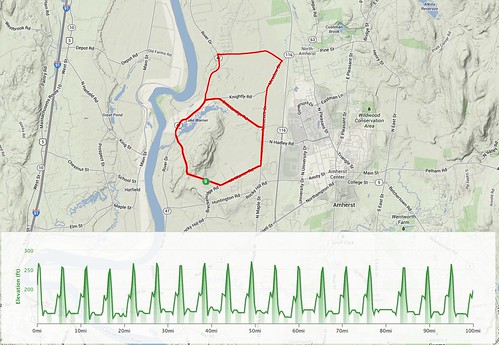
(Jennifer and I ended up doing one slightly longer loop, up to Comins Road, so that I could reach 100 miles with only 18 laps.)
The equipment
I was riding my Surly Long Haul Trucker, equipped with stainless steel fenders and racks, and way too much space in the handlebar and saddle bags, in case the urge suddenly struck to buy a bunch or two of asparagus from one of the roadside stands I passed.
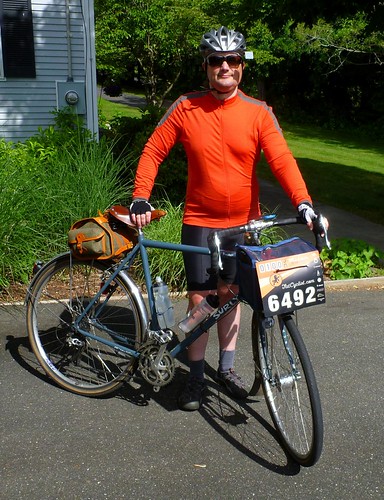
The ride
June 1 was hot and muggy here, so I decided to wait until the weather was nicer. The forecast for Wednesday, June 6, looked propitious: high in the mid-70s, sunny turning into partly cloudy, and winds under 5 mph. Well, it was right about everything except the wind. About an hour into the ride, a moderate southerly wind sprung up, shifting between SSE and SSW. Because of Mt. Warner’s effects on wind patterns, I had the wind against me when heading south, but much less behind me when heading north. Wind is like that.
I set off about 9:40 am and did my first loop: past some houses, into the woods, downhill past a couple abandoned houses, more woods, a farm with donkeys grazing, and more houses, across the Mill River into the village of North Hadley. (North Hadley is a village in the town of Hadley, while South Hadley is an independent town. Are you confused yet?)
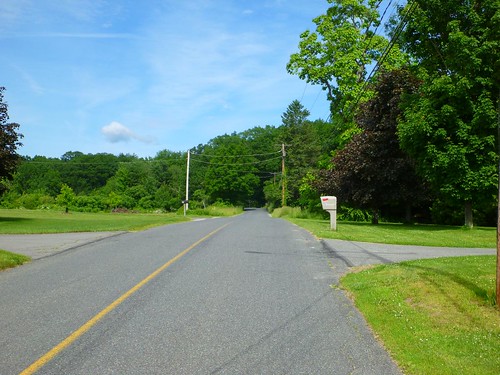

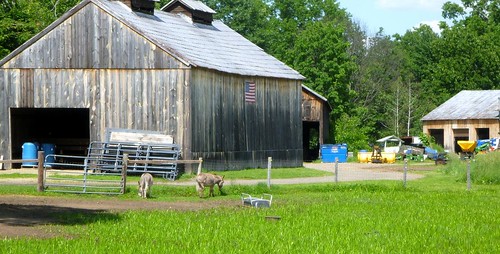

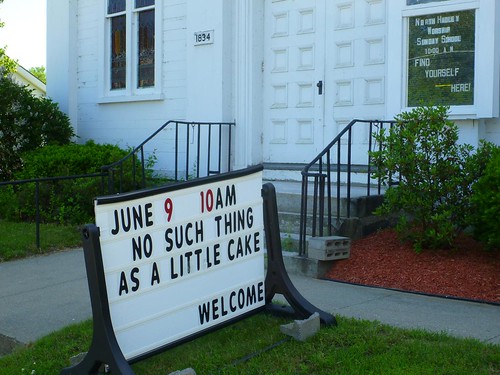
Leaving the village, I passed strawberry, hay, and tobacco fields. (There’s a lot of tobacco grown here for wrapping cigars.) The campus of the University of Massachusetts Amherst, my employer, rose up in the distance. Turning a corner, I passed more farms and farmstands, including the Full of Grace farm, which offers riding lessons and equine therapy (presumably therapy using horses, not for horses). I crossed the Mill River again, further upstream, then more farm fields, a cemetary, and a subdivision that was oddly planted in bucolic farmland. And for most of the ride, I could see the slopes of Mt. Warner. Just before home, I saw the grapevines of Mount Warner Vineyard, operated by one of our neighbors. And then it was back uphill. Lather, rinse, repeat. Occasionally I saw rural sights: cattle grazing, migrant workers planting, bales of hay being launched from the baling machine into the trailer behind it. I also smelled the remains of a dead possum far too many times.
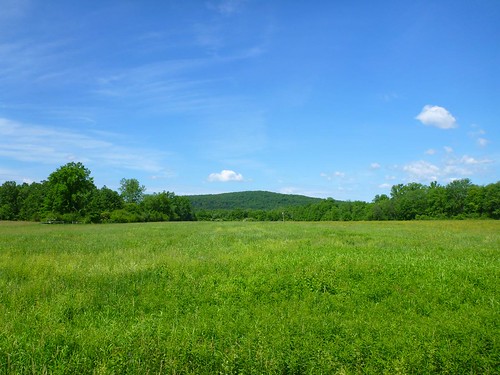
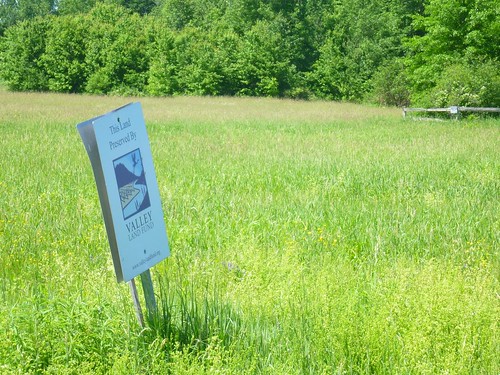

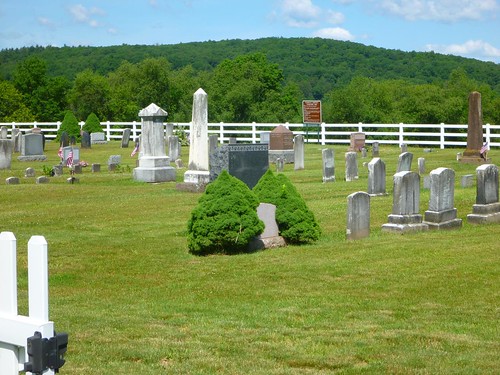
On my 5th lap, I was joined by Jonathan O’Keeffe from the Northampton Cycling Club – I had posted on the club’s forum about my ride. He stuck with me to the end of the 6th lap (32.5 miles), when I took my first aid station break to eat a peanut butter sandwich, refill my bottles, and apply chamois cream liberally. It was great riding with him, but he was a stronger rider, which encouraged me to go faster than I should have (I’m not blaming Jonathan – it was my own decision, and it was fun to push myself a bit). My second set of six laps showed me that I had started out too fast. After a second break, at 65 miles, I wasn’t sure I had 35 miles left in me: my back was aching, a muscle in my butt and thigh was sore, and my right knee was twinging. I thought I might do another 10 or 20 and then call it quits.
Jennifer (my wife, for anyone reading this who doesn’t know us) ended up saving the ride. She had offered to do a few laps with me after my second rest break. I’m somewhat faster than her, so riding with her meant I had to go a few mph slower than I had been. After a couple miles, my back and knee were feeling fine, and a few miles further, that pesky muscle quieted down. She had intended to just do 2 or 3 laps, but she ended up riding for 30 miles! I realized while we were riding together that if we did one slightly longer lap further north, I could finish in 18 laps without having a couple extra miles. So we did that, seeing some new sights for the day.
Sooner than I had expected, it was time for the final lap. I was again riding alone, so I picked up the pace to see whether I still had any gas in the tank. Surprisingly, I did; it wasn’t my fastest lap of the day, but it was in the top five. I reached the driveway at 100.0 miles and rolled a dozen yards up. The ride was over. And of course I had won my division: guys riding around a grandiosely named hill in western Massachusetts. Thanks, Fatty, for giving me the chance to podium!
The stats
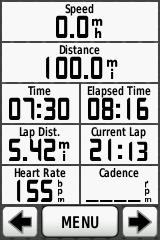

(In the end, I’m not sure how much I climbed. When I pre-rode 3 laps, my Edge 800 told me the total elevation gain was 616 feet, or about 205 feet per lap. That squares with what RideWithGPS claimed. But for this ride the Edge reported 3028 feet. The ride is on Strava for anyone who’s interested: http://app.strava.com/activities/58475310)
— Brian W. Ogilvie
Cycling, Randonneuring
May 31, 03:03 PM
Here we are at the end of May! Since it’s unlikely I will do a bike ride this evening, I thought I’d give a brief summary of the month.
Cycling: I rode 425.95 miles (685.5 km) in 33 hours, 48 minutes, 23 seconds (some of the commuting times were approximate, though). Excluding commutes, I rode 351.93 miles in 27:15:07, so my commuting total was 74.02 miles in 6:33:16. My average commuting speed was 11.3 mph, while my average on the other rides was 12.9 mph. On my 9 solo rides, I rode 211.18 miles at an average speed of 14.6 mph.
I rode on 22 of the 31 days of May.
Weight loss: 5.78 lbs. over the course of the month (the difference between my exponentially smoothed weighted average today and that of April 30).
— Brian W. Ogilvie
Cycling, Idle Thoughts
May 27, 09:50 AM
Yesterday was cold, overcast, and windy, so I spent a few hours in the basement tidying up my work area and getting the All Road ready to ride. That meant adjusting the saddle and handlebar height, then installing brake cables and housing. Projects like that always take me longer than I think they should, but it’s now done: I took the bike out for a short spin. It looks a little odd without handlebar tape, but it is rideable. The ride feels smooth and fast, though without a cycle computer it’s hard to tell whether that impression correlates with objective measurements.
The front tire threw up a bunch of sand and gravel as I passed over the thin line that our yard service raked off the lawn in early April, and that the town still hasn’t picked up. That’s a reminder, if I needed one, that fenders are a good idea. The lovely hammered Honjo fenders aren’t pre-drilled, so I’ll have to allot a couple hours to installation, including crimping them where they need to clear the chainstays and fork blades. I don’t want to ride the bike much until that’s done.
Shifting seems OK, though I am not sure about the downtube shifters. I’m used to barcons, which I have on my other long-distance bikes. I’ll give them some time, though. They definitely were easier than barcons to cable up.
I’ll post pictures soon, though now that I have the handlebar height roughly adjusted—slightly below the saddle—the uncut steerer looks ridiculous.
— Brian W. Ogilvie
Cycling, Idle Thoughts
May 23, 03:23 PM
It’s been rainy for the last few days. We can certainly use the rain, though the thunderstorms that woke me up Tuesday night/Wednesday morning were a bit much. It has made cycling a bit trickier. I don’t mind getting wet, but being out in a thunderstorm is another matter. Tuesday I managed to get in a 16-mile ride (including a stop at the Millstone Market in Sunderland for a couple of onions), but 4 miles from home the heavens opened, as I feared they would. It was actually rather nice, since the temperature had been in the mid-80s and it was very humid. I’m not used to that after our cold spring. The rain, at about 70 degrees, cooled me down effectively. I was drenched but happy when I got home. My Zugster handlebar bag and Nigel Smythe tweed saddlebag kept my stuff nice and dry.
After breakfast this morning it looked as if I would have a little more than an hour until rain arrived, so I plotted another outing: a 16-17 mile, mostly flat loop (15.7 miles, but with an option to extend to 17). I’ve gotten somewhat faster; a year ago I would have considered 13-14 flattish miles to be an hour’s ride. I had a moderate tailwind for the first half of the ride, and a moderate headwind for the second half, but I still finished 17 miles in only an hour and 5 minutes. It feels good to have improved that much.
So far I’ve gotten in about 54 miles this week. I want to do 50 miles over the weekend, in preparation for the 100 Miles of Nowhere the following weekend, but the weather doesn’t look wonderful. Monday’s looking better, and it’s a holiday, so perhaps I will stretch the week a bit! I did 107 miles each of the last two weeks, so I’m not doing too badly on my goal of riding a hundred miles a week this summer. (I’ll certainly fail to reach it some weeks, but it’s an aim.)
Boulder All Road update
I got a new beam-style torque wrench last week and installed the cranks, then installed the pedals. A day later I installed the derailleurs and shift cables, shortened the chain to the proper length (2 links longer than recommended, since I will be using the big ring-big cog combination regularly, but not the small-small combo), and got the drivetrain running.
Just a couple more steps before I can ride the bike: installing brake housing and cables, adjusting the brakes, tightening the headset, and dialing in the saddle height. With all this rain, it might be done soon! I’ll still have a few things to finish: fenders, lighting, and handlebar tape. And once I get the bar height adjusted, the steerer can be cut to length.
Here’s how it looks right now:
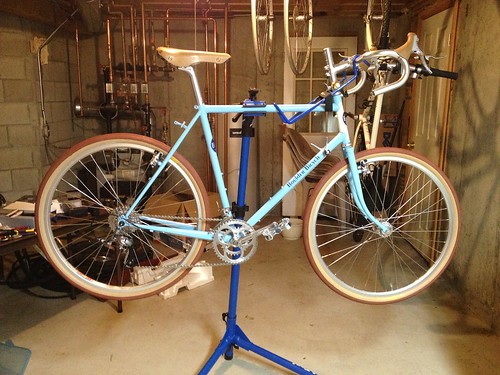
— Brian W. Ogilvie
Cycling, Idle Thoughts
May 16, 11:09 AM
Now that the semester is over, I’m back to working on the Boulder All Road. Yesterday I installed the bottom bracket, greased the tapers (per the crank manufacturer’s recommendation), and started to install the cranks. I didn’t get very far, though, because the torque wrench I inherited from my father has a 1/4” driver, and though I have my own socket set plus the larger set that he owned, neither of them has a 1/4” to 3/8” adapter.
I’m not sure I trust the torque wrench, anyway. I’m not sure it was dialed down to zero tension, in which case the spring might have set. I might buy a cheap needle-style wrench, just to be sure—better to spend a few extra dollars than wreck a crankset!
Some upcoming rides
Once the All Road is ready to ride, I have places to ride it! I’m signed up for the 100 Miles of Nowhere on or around June 1, the 115K version of D2R2 (the Deerfield Dirt-Road Randonnée) on August 24, and the 170K Great River Ride on October 13. D2R2 is shorter, but the 115K version has over 8,000 feet of climbing; there are 150K and 180K options, but since I’m still heavy and haven’t gotten too much climbing in yet this year, I wanted to start off easy(ish).
Still losing weight: about 20 lbs. since January 7.
— Brian W. Ogilvie
Cycling, Randonneuring
Apr 22, 03:13 PM
April 22 post
If I’m going to attempt the Shelburne Falls 200K next Saturday, I need to get in a good training ride today. It’s sunny with temperatures in the mid-40s and northerly winds 5-15 mph. I’m planning to ride north-northeast through Leverett and Wendell to Warwick, then head west to Northfield and back south via Erving, Montague, and Sunderland. We’ll see how it goes—I’ll post an update later.
Update, April 23
I did the ride, and a few extra miles to round it out to 70. Left home a couple minutes before noon, and returned at about 5:50 p.m. I spent 5 hours and 24 minutes moving, plus another half hour stopped, all told. The first half of the ride was largely uphill, from Amherst through Leverett, past Lake Wyola in Shutesbury, then up to Wendell Center. I had a downhill run to Wendell Depot, followed by a ride up Moss Creek Road to Laurel Lake. After a brief circuit of “downtown” Warwick, I headed west toward Northfield.
A couple miles west of Warwick, I reached the second half of the ride: a long downhill into the center of Northfield, followed by a mostly flat ride home, with a few hills to keep my legs limber.
It was a gorgeously sunny spring day, starting out chilly (temperatures in the low 40s) but warming up into the mid-50s as I continued, despite climbing up into the hills. There was a 5-10 mph wind from the north, though, which made the first half of the ride more challenging than it would otherwise have been. The wind was at my back for most of the ride home, but it had diminished in intensity.
I had a slice of bread with peanut butter just before leaving home; while riding I had a peanut butter sandwich, a Clif bar, and 40 oz. of regular Gatorade that I picked up at the Wendell Country Store. All told, I probably consumed about a thousand calories before and during the ride, which is not too much less than the maximum I can digest. Despite sucking down sugar water, my tummy was feeling empty by about mile 55. I had forgotten that feeling from longer rides—this was my longest ride since May 2010.
Now I need to decide whether to do the Shelburne Falls 200K next Saturday. My legs were tired yesterday but only slightly sore in a couple spots. I cycled to work today and felt OK, though going into the wind was a little tougher than usual. But I’m not sure my rear end is up to another 55 miles in the saddle. The last time I rode a 200K, I built up to it more gradually, with 50, 60, 70, 80, and 100-mile rides before the big one.
Photographs are in a set over at Flickr. And a map with some statistics is available on Strava.
— Brian W. Ogilvie
Cycling, Randonneuring
Mar 15, 01:55 PM
Western Massachusetts has moved into maple sugaring season, also known as mud season: that period between winter and spring when the days get well over freezing but the nights are still cold. The sap runs in the maple trees, flowing out through taps into collecting buckets or plastic hoses that lead to barrels of sap. The sugar shacks are at work, belching out smoke as the sugarers boil 40 gallons of sap down to a gallon of syrup. And the snow has mostly melted, at least down here in the valley, soaking the earth and leaving huge swaths of mud wherever the ground vegetation isn’t firmly established.
Work has been busy, but I’ve been able to shoehorn cycling into my schedule. I did some rides outside in January. February’s “rides” were all inside on rollers, including one 30-mile, 2-hour bout. Since March 1 I’ve been able to ride outside again, including a trip up to Lake Wyola and another to Conway, where the snow is still thick on the ground. I’ve put a few snapshots from recent rides up on my Flickr site.
I’m still building up my Boulder All Road bicycle. It will be rideable after I add the bottom bracket, crankset, pedals, derailleurs, and brake and shift cables. Then I’ll need to finish it off: install fenders, front rack, and the lights; wrap the handlebars; and, after riding for a while, fine-tune the handlebar height and cut the steerer, which is now absurdly long.
And finally, I’m still losing weight, slowly but surely.
— Brian W. Ogilvie
Cycling, Idle Thoughts
Jan 23, 04:29 PM
I started out 2013 weighing nearly 215 lbs. (214.8 on January 7, the morning after I got home from holiday travels). I’d like to weigh 170 by the beginning of 2014. Here’s how I’ll do it:
- Count calories, so that I take in less energy than I expend. I’ll use Myfitnesspal.com and its associated iPhone and iPad apps to calculate my calorie target and track my daily calorie intake.
- Exercise regularly, and use my Garmin Edge 800 and ForeRunner 410 to track calories expended in cycling, hiking, etc. I’ve been exercising regularly for years, with occasional breaks during vacations and illnesses, but I am going to add regular interval training and weightlifting.
- Use Beeminder.com to produce a nifty graph showing my target and progress:

So far I’m two weeks in and the process seems to be working.
Why am I doing this?
I’ve gotten fat, my blood pressure is creeping up, and I have a family history of diabetes and arterial blockage. On top of that, I had a bout of back pain in September that started out acute but risked becoming chronic. Losing weight and watching cholesterol are good ideas. (As an aside, my physical therapist prescribed core strengthening exercises that have been marvelous for eliminating back pain.)
I also want to become a faster cyclist and participate in some organized rides this year. To attain that goal, I need to train for speed and endurance, but it would also help to lose weight—especially in hilly western Massachusetts!
I picked 170 lbs. because I felt pretty good when I weighed that amount and it’s a reasonable goal for a year. I won’t necessarily stop there. I’ve weighed as little as 138 lbs., or possibly less, in my adult life.
My history of weight loss and gain
Having been a fat kid (“husky” was the preferred euphemism back in the day) and a fat college student, I decided to do something about my weight and fitness after graduating from college. I had never been completely sedentary—as a kid, I did a lot of hiking and backpacking in the Boy Scouts, and in college, I walked all over Hyde Park. But my weight kept creeping up, and after an attempt to jog a few blocks failed in less than a hundred yards, I decided to get serious losing weight and getting some aerobic fitness.
My approach was simple: get more exercise. As an employee and then grad student at the University of Chicago, I had access to the university’s pool and field house, so I started swimming and some moderate weight training. After a couple of years I’d taken off a number of pounds, and I’d switched primarily to running. I didn’t bother to count calories or diet. I’m not sure what my starting weight was—perhaps 180 lbs.?—but by the time I started keeping a running log in November 1994, I was down to 138. I also had a morning pulse that was usually between 48 and 52, and sometimes as low as 46. I was running 10-20 miles a week. I felt great. My only problem was finding off-the-rack trousers that fit; I needed a 28 or 29 waist, but many shops didn’t carry sizes under 30.
(I may have weighed less in 1993 or 1994. I didn’t keep weight records before November ’94, but I do remember some readings in the high 120s on the scale in the Bartlett Gym locker room. That scale seemed to read low, though; the Healthometer scales in the Field House tended to show numbers in the mid-130s.)
In the late summer of 1995 I moved to Berlin. There, I kept running for a while, but my knees started to give me trouble. I bought a bike for commuting but didn’t do much serious aerobic exercise on it. I started to put on weight. Back in Chicago in 1996-97, I walked but don’t remember doing much else.
Then I got my tenure-track job at UMass Amherst. We moved to Massachusetts in July 1997, and though I bought a bike and rode it occasionally, I didn’t really get back in the habit of exercising. I started running again in the fall of 1999 but had knee and ITB problems. That semester, my weight crept up from 168 to 174. It continued to increase slowly, until reaching a high point in the summer 2008, after my father’s death, when I weighed about 223 or so. Something had to be done.
What I did was to start cycling regularly. Exercise had worked in grad school—why not now? I did start to slowly lose weight, especially in the spring of 2010, when I was training for a 200K bike ride, doing lots of long, moderately paced rides in the hills. By the time I moved to France in the fall of 2011, I was down to about 205. Then, in spring, summer, and fall of 2012, I put on 10 lbs., despite exercising regularly. Evidently, something had changed: either my eating habits had gotten worse, or my metabolism had shifted. I needed a new plan: the one I mentioned above. We’ll see how it goes.
— Brian W. Ogilvie
Idle Thoughts, Cycling
Jul 14, 12:53 PM
Now that MobileMe has closed down, it’s time for me to actually do something with this space to replace my personal pages there. In my copious free time, that is! Look for some changes later this summer/early this fall.
— Brian W. Ogilvie
Idle Thoughts, Site Admin
Oct 10, 09:30 AM
My current research project is a book tentatively called “Nature’s Bible: Insects in European Art, Science, and Religion from the Renaissance to the Enlightenment.” I’m working on it during my sabbatical in 2011-12, including a six-month residential fellowship at the Institut d’Études Avancées in Paris. What follows is the description I wrote for a grant proposal.
At first glance there is a puzzling imbalance between the title and subtitle of Jan Swammerdam’s book The Bible of Nature, or the History of Insects reduced to distinct classes (written in the 1670s but not published until 1737). This book project aims to resolve the puzzle: to show how the intense interest that early modern Europeans took in insects, from the late Renaissance to the Enlightenment, was not merely an episode in the prehistory of entomology but, in fact, drew together powerful currents in what we now think of as the distinct realms of science, art, and religion.
One of Swammerdam’s near contemporaries, the eighteenth-century German Protestant theologian Friedrich Christian Lesser, was also surprised by Swammerdam’s title, but the nature of his surprise reveals the gap between eighteenth-century perspectives and our own. In his Insect Theology, Lesser wrote that Swammerdam’s book should have had a more precise title: “For the Bible of Nature includes everything that has been observed about the visible world….the history of insects comprises only a chapter of the Bible of Nature.” Lesser’s objection was not that Swammerdam brought together religion and insects—Lesser’s own book, after all, was an Insect Theology, and he also wrote a Rock Theology and a Shellfish Theology. It was that Swammerdam overweeningly took the part for the whole.
But Swammerdam might have responded with the Plinian maxim with which Lesser opened his own book, “Maxima in minimis”: Nature reveals her powers nowhere more clearly than in the smallest creations. Other early moderns would agree: the self-taught court painter Joris Hoefnagel, who placed insects along with rational creatures under the element of fire; the Dutch statesman Constantijn Huygens, who inherited some of Hoefnagel’s works; the German painter Maria Sibylla Merian, who traveled with her daughters to Suriname in order to study tropical insects and their metamorphoses; the Italian anatomist Marcello Malpighi, whose treatise on the anatomy of the silkworm was written at the request of the Royal Society of London and published by its press in England. They are but a handful of the hundreds of early modern Europeans who observed insects, collected them, painted them, described them, exchanged them or their descriptions, and published works that blended the realms of art, science, and religion.
Nature’s Bible will address a broad chronological range: roughly two centuries, from the late sixteenth century through the middle of the eighteenth. It will be a cultural history that brings together the history of ideas, the history of science, art history, the history of collecting, and the history of religion, and I hope that scholars and readers in all those fields will read it with pleasure and profit. But it will not be sprawling or amorphous. The guiding thread of its narrative will be not only insects but the connections that bound together early modern students of insects. Beginning with sixteenth-century natural history and the revival of interest in the works of Albrecht Dürer, I will show how insects, knowledge about them, and the symbolic meanings elaborated from them circulated throughout early modern culture. Just as insects are an essential, if often invisible, part of the earth’s ecosystems, so too were they a central part of early modern cultural ecology.
By tracing the paths taken by the cultural circulation of insects, and the ways that knowledge was transformed as it circulated, I intend to show how the boundaries of early modern categories of thinking—art, science, religion—remained permeable even as they were being strengthened. Indeed, in the middle of the sixteenth century the terms “art,” “science,” and “religion” are in many ways anachronisms. By the middle of the eighteenth they were not; they had taken on many of their modern aspects. Yet even in the heyday of Enlightenment, the Dutch civil servant and amateur anatomist Pierre Lyonet could produce an annotated translation of Lesser’s Insect Theology, the annotations serving to correct the entomological errors that Lesser had made. August Johann Rösel could produce his Monthly Insect Entertainment, published in German and featuring detailed engravings of insects along with lengthy descriptions of their behavior, for an audience that included pastors and physicians, collectors and naturalists. Even as entomology was crystallizing into a distinct discipline—the word was coined in 1745—insects could cross cultural, social, and disciplinary boundaries.
— Brian W. Ogilvie
History,
Aug 7, 06:42 AM
Jennifer and I took a trip to see the remains of a Roman villa near the village of North Leigh. Getting out of Oxford by bike is rarely picturesque. This time we rode north to the A40 and followed the cycle path along it for a few miles before turning off onto quieter roads. The traffic was irritating but the path itself was generally decent: not wide enough to ride two abreast, but generally in good shape. I’d happily use it again to get quickly to the northwestern part of Oxfordshire.
By the route we took, the villa was about 11.5 miles from Oxford. It was a quarter mile from the road, down a rough unpaved track. We cycled parts of it and dismounted for the rockiest bits. The ruins were impressive and included a restored mosaic protected by a modern structure. Unfortunately the door was locked so we had to admire the mosaic through the windows.
Afterwards we cycled another 5 miles to the rail station in Charlbury. Jennifer took the train back to Oxford, while I rode back. After the first 4 miles of backtracking, I took a different route—one we had taken last year in the other direction, through North Leigh, Eynsham, and Botley. Most of the way there was little traffic. It was exhilarating to cycle along in the sun, with a light wind sometimes helping and sometimes hindering, with the occasional steep hill offset by a general trend downward toward Oxford. I haven’t felt such sheer joy in cycling since leaving the US. Our tour in the Netherlands was fun, and I’ve had some good rides in Oxford before this, but yesterday’s return was simply thrilling.
Our ride to Charlbury was about 16.5 miles, and my return about 18.4, for a total distance just shy of 35 miles. I reset the GPS in Charlbury, so the ride is recorded in two segments: part 1 and part 2.
— Brian W. Ogilvie
Cycling, Idle Thoughts
Jul 21, 04:19 PM
I haven’t blogged here much lately (obviously). It’s been a low priority compared with work and with planning to spend 14 months overseas.
A couple of cycling-related things to note, though:
1. Jennifer and I did a 7-day bike tour of the Netherlands in June and July. The trip narrative is online at http://www.crazyguyonabike.com/doc/BrianOgilvieNetherlands2011
2. We hosted our first WarmShowers.org guests this July—a couple of South Korean cyclists who have been traveling around Europe for four months. We put them up in the Oxford college that houses our summer program and took them out for a couple of pints and a pub dinner. Lovely, charming people. I admire their gumption in traveling from Istanbul to Spain, then over to Ireland and England.
I’ll be doing some more cycling this summer and over the 10 months, from Sept. 2011 through June 2012, when I’ll be based in Paris. I’ll try to blog the interesting bits here. And ultimately I hope to turn this site into more of a home on the Internet range, if time and technical skills allow.
— Brian W. Ogilvie
Cycling, Photography
Apr 25, 10:18 AM
The Pioneer Valley is great for cycling. On this page I intend to post some of my favorite area rides. Though I usually leave from my house, I’ve set these rides up so that they start and end somewhere with a reasonable amount of parking.
40-mile loop from Northampton to Conway, Deerfield, and Sunderland.
This loop begins and ends at the parking lot at the western end of the Norwottuck Rail Trail, off Damon Road in Northampton. It begins by following the Northampton Bike Path to Look Park, then heads up through Williamsburg and Whately, past a couple of Northampton’s reservoirs, to the hill town of Conway. Then it’s downhill all the way to the Connecticut River. On the eastern side of the river, the route heads through Sunderland and Hadley along the flood plain of the Connecticut, past fields and tobacco barns, finally picking up the Norwottuck Trail for the short trip back across the river to the starting point. There’s a restroom at Look Park and a couple of small groceries in Sunderland. Around mile 30.5, Smiarowski’s farm stand has soft serve ice cream and sandwiches in season (roughly May through September).
Map on MapMyRide.com
More to come!
— Brian W. Ogilvie
Cycling,
Apr 3, 10:55 AM
After a long, harsh winter in New England, I’ve been back on the bike. My Surly Long Haul Trucker is still in the basement on rollers, where it has been since December, but I’ve set up the New World Tourist for my outdoor rides. When I’ve ventured onto muddy dirt roads, the NWT drivetrain gets a little crudded up, since the medium-cage rear derailleur is close to the ground, but otherwise it’s a fine bike. I recently moved the handlebar bag off of the handlebar onto a Klickfix adapter that’s attached to the NWT stem riser, which makes the handlebar less cramped and the steering a little smoother.
I’ve been riding rollers all winter (except for the holiday trip to Michigan), but I haven’t been building up endurance on longer rides due to the snow and to my normal pattern of being overcommitted at work. My longest rides this year have been 30 and 33 miles. The 30-mile ride was on a rented hybrid in Charleston, SC—not the most comfortable bike, but the terrain was flat. The 33-mile ride involved a little climbing up to Leverett, including a couple of short steep (10-12%) hills, but no serious sustained climbs.
In short, I’m not sure that I’ll be ready for the Berkshire Brevets 200K on April 30. If I do want to try that, I need to get in at least a couple long rides, and ideally at least one of 80 miles. Whether that will work…we’ll see!
— Brian W. Ogilvie
Cycling, Idle Thoughts
Oct 23, 08:36 PM
Of course I’ve been back on the bike ever since getting back from Ireland. I did go four days without cycling earlier this month due to a trip to Buffalo over the long weekend; I took my New World Tourist but didn’t have a chance to ride. Otherwise, I’ve been cycling regularly, with 1 or 2 days off from time to time.
But a lot of that has been commuter cycling: the 6-mile round trip to work, with occasional jaunts elsewhere. I didn’t end up doing the Great River Ride in any of its variants because I spent that weekend visiting my stepfather in the hospital and keeping my mom and sister company.
But now I have a plan.
Today’s ride: 45 miles to Wendell and Millers Falls
Today I took my longest ride since my 200K in May. It was a cool, partly sunny day (temperatures in the mid-50s F, about 13 C). I rode over Mount Warner and then north on Route 47 until its end in Montague. I then rode up North Leverett Road to Lake Wyola, and thence on Locke’s Pond Road to the center of Wendell. I paused there for five minutes to eat a clif bar and swig some water. Then I took Montague Road toward Millers Falls. I had to use my granny chainring on one hill, but I was rewarded by a thrilling descent. From Millers Falls I took Route 63 back to North Amherst, and then headed home on Meadow, Roosevelt, and N. Maple.
I was not a speed demon, but I did respectably given how long it had been since I did a long hilly ride (2503 feet of vertical climbing, according to my altimeter).
Here’s a map.
The plan
It’s not much of a plan, actually, but I am going to try to do a couple of 200K brevets in the spring, and maybe a 300K if the 200Ks go well. Randonneurs USA has published the 2011 brevet schedule, and the Berkshire Brevets schedule includes a 100K populaire on March 20, followed by 200K brevets on March 27 and April 30, and 300K brevets on April 9 and May 14. (Their 400K is on June 4….) I might not do the populaire if I’m visiting friends in DC that week, but I’ll aim for the 200Ks at least. I know I can do that distance.
Between now and then, I’m planning three weekly workouts: an hour at tempo, 45-90 minutes of intervals with substantial rest, and one long slow ride for endurance. If weather permits I’ll ride outside, but odds are that much of this will be in the basement on rollers. When February rolls around I’ll try to get in some longer rides on the road: riding on rollers for more than 2 hours is a real drag. And I’ll try to add a weekly hill workout. My hope is that the intervals and tempo rides will help me get my average speed up to something respectable.
That’s the plan, anyway! We’ll see how it measures up to the reality imposed by the demands of work and the holidays.
— Brian W. Ogilvie
Cycling, Idle Thoughts
Sep 25, 11:33 PM
This fall has had some transitions and some unexpected bobbles:
I finished my term as Graduate Program Director in my department, so I’ve gone back to teaching two courses in the fall. I’ve taught both my regular courses before but I’ve revised them both extensively, so there’s a lot of work there.
I’m also teaching a new first-year seminar on “People and Insects”—fascinating subject, if I may say so myself. That’s connected to my new book project on insects in European art, science, and theology, c. 1580-1750. I’m currently applying for fellowships to support a sabbatical research year in 2011-12 to work full-time on the book project.
On the administrative side, I’ve taken on the co-directorship of our university’s new Digital Humanities Initiative, which mostly involves writing budget memos and coordinating events at the moment. My co-director, Donna LeCourt, has done most of the heavy lifting so far.
On the bobble side, my stepfather had a serious accident a couple weeks ago while helping to dock a boat, and he’s been in a trauma ICU in Buffalo, NY, ever since. I’ve made one trip there so far and am planning another this coming weekend.
My cycling has been affected accordingly. I’ve done 75-125 miles per week since getting back, including a daily commute as much as possible. I had been thinking about doing the 170K/112 mile Great River Ride on October 12; I might still do that, or I might do the 62- or 80-mile options. The 62-miler would be a cakewalk; 80 miles would be possible but a lot more work, and the 112-mile ride would be a real challenge. My longest ride this fall has been about 40 miles, and I’ve done 75 miles over two days. I probably can’t get in another long training ride before Oct. 12, so what I’ve done is what I have to work with.
— Brian W. Ogilvie
Cycling, Idle Thoughts
Sep 8, 10:21 PM
I certainly wasn’t posting here. Of course the dearth of comments and emails suggests that no one has been reading this anyway. But in case anyone is still out there, I wrote a Crazyguyonabike journal for the 9-day bike tour that I did in Ireland this August:
http://www.crazyguyonabike.com/doc/BrianOgilvieIreland2010
It has a narrative, with perhaps too much detail, along with a bunch of photos of gorgeous Irish landscapes and some quirky things I saw during the tour.
— Brian W. Ogilvie
Cycling, Photography
May 9, 03:50 PM
Indeed, what next? I’ve done a 200K ride, and while it wasn’t a sanctioned brevet, it was comparable. I did it within the overall time limit and arrived at control locations when they would have been open. In short, I achieved the first goal that I set myself over the holidays: train for a brevet series. And I did, unofficially at least, the first element in the second goal: attempt the series.
I probably could have tried the 300K yesterday, though the weather was nasty enough that I’m content not to have done so. I’ve learned over the course of the spring, though, that my unsystematic training “regime” was not ideal for riding brevets. I got the miles in, and my long weekend rides prepared me for the distance, but I didn’t work systematically on speed and hill climbing. As a result, I didn’t ride as fast on the 200K as I had wanted, and the hills took more out of me than they should have. I did figure out what works for me nutritionally.
The $64 question is whether I continue. I don’t think I can afford the time required to ride brevets this summer, except maybe a 200K in late July or early August if it’s not too far from Oxford. I might see about a 200K back in the States in the fall, but the Berkshire Brevets isn’t doing one, so it would mean traveling.
If I continue to ride 30-75 miles on most weekends, plus shorter rides during the week, I can maintain the base required to train for and ride a series in 2011. That might be a more reasonable goal, perhaps with the Great River Ride 170K and another century in the fall to keep on top of long-distance riding.
In that case, I’ll work on speed and hills this summer. It looks like I can ride 3 miles from my Staverton Rd. flat to Wytham and then climb a serious hill. I could even stop at the Trout for a pint on the way home! Of course I should also be working on losing a little weight, which suggests that the pint might not be such a good idea….
I’ll keep posting occasional updates and ride reports here, just in case anyone is reading (though mostly for my own sake).
— Brian W. Ogilvie
Cycling, Idle Thoughts













